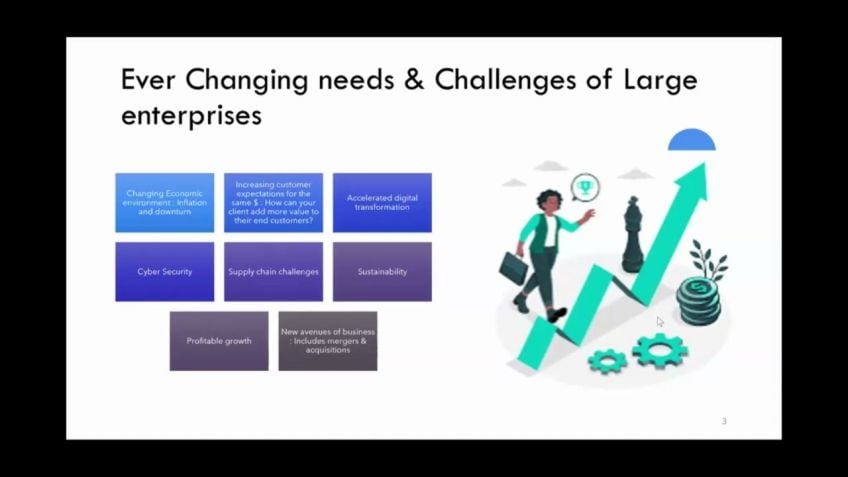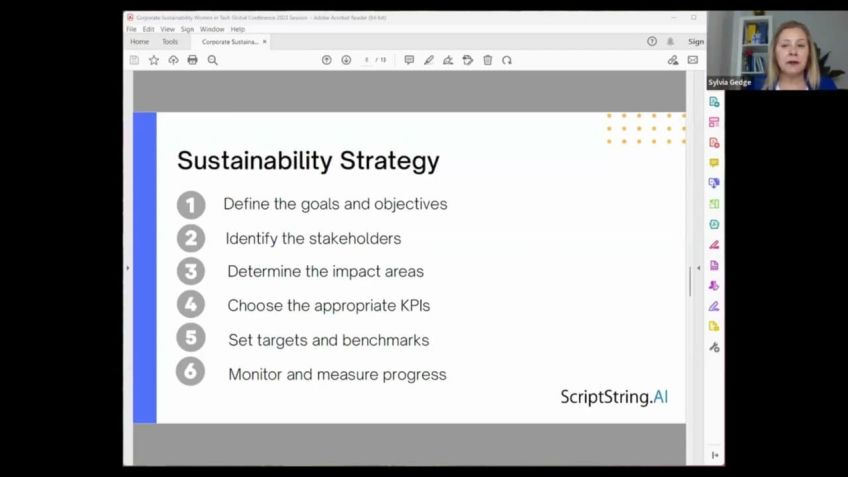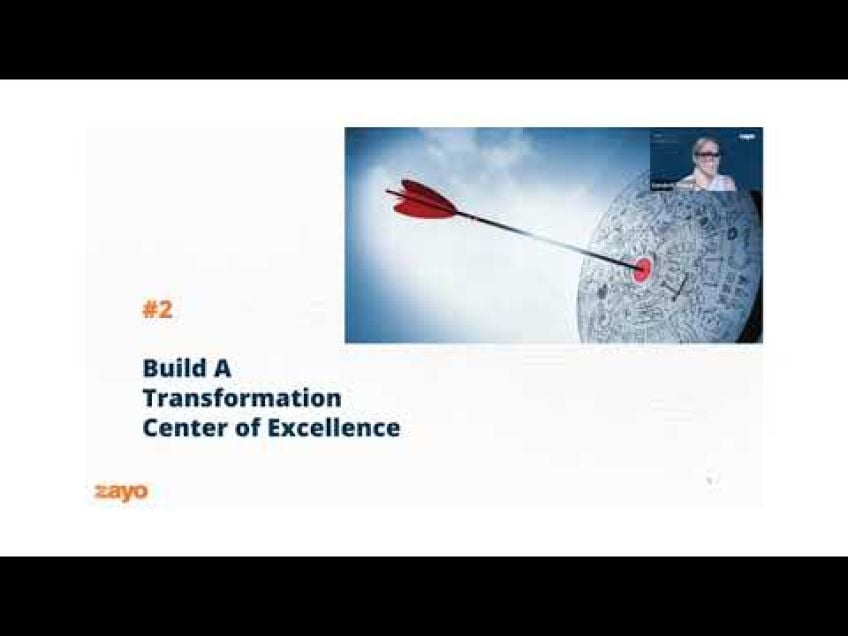How digital transformation should drive the energy transition
Annamaria Arcese
Regional Sales DirectorDigital Transformation Driving Energy Transition
Written by Anna Maria Chase, Regional Vice President in Sales Force
As we face the urgent challenge of climate change, we also grapple with transitioning to a net-zero emission energy system. This, while also meeting the growing demand for energy. Today, we'll discuss how digital technology and AI can play a critical role in driving this energy transition.
Understanding The Urgency
The impacts of climate change are growing day after day. However, the current commitments put us on a path to reduce emissions by only 7.5% by 2030. Significant change is needed to reach a 55% reduction and keep the Global Agreement on track. We all must consider highly efficient, circular, and sustainable ways to make a meaningful impact on emissions - and digital technology can prove instrumental in this journey.
Embracing Digital Technology
Digital technology is transformative. It has seeped into every aspect of our lives, and in the context of energy efficiency, it presents novel ways to operate energy systems, improve operations, enable sharing economy, track greenhouse gas emissions, and more.
While digital technology is powerful, we must also tread cautiously. According to estimates, ICT is responsible for between 2.1% and 3.9% of global greenhouse gas emissions, similar to the aviation sector. Thus, the projected increase in digital innovation also raises concerns around increased direct material impacts.
ESG Factors and Sustainable Development
Amidst growing pressure from various stakeholders, businesses are finding themselves at the crossroads of implementing digital solutions to meet Environmental, Social, and Governance (ESG) goals.
- 83% of consumers believe companies should be actively championing ESG best practices.
- Around 70% of employees expect their company to have an ESG agenda.
- 85% of investors consider ESG factors in their investments.
- 91% of banks along with 24 global credit rating agencies monitor ESG.
The approach towards ESG goals is shifting from voluntary disclosure to becoming more regulated, leading to CEOs adopting ESG strategies for competitive advantage.
Potential of Digital Solutions
An efficient digital strategy can potentially reduce global emissions by 20%. How?
- Sharing of autonomous, transparent data to optimize resources and enhance efficiency.
- Prioritizing digital inclusion and skill development to ensure workers have access to digital technologies.
- Fostering cross-team collaboration within businesses and across industries.
The key here is to focus on an inclusive, sustainable digital transition that benefits everyone.
Sustainable Digital Transformation
A sustainable digital transformation relies on five pillars – prioritizing measurement, building infrastructure, conducting impact analysis, changing leadership model, and making conscious technology usage choices.
The COVID-19 Impact and Future Directions
The COVID-19 pandemic significantly impacted the focus on digital transformation and environmental sustainability. While 38% of organizations globally decreased their attention on sustainability, 18% put it all on hold. Simultaneously, 46% of organizations have increased their focus on digitalization, indicating an imbalance between the two.
Moving Forward: Balancing Digitalisation and Sustainability
It's evident that digital sustainability is becoming an essential discussion. However, it's equally important to strike a balance between technological developments and environmental benefits. We must remember that every digital footstep counts towards the environment's well-being – hence, measuring the combined carbon footprint of technology manufacturers, infrastructure, and billions of internet users is crucial.
In conclusion, the responsibility is not only on companies but also on the consumers. We all must be aware of the environmental impact and make conscious, responsible choices. It’s a collective effort, and with awareness, the right mindset, and sustainable solutions, we can drive the energy transition successfully.
Make every day a day for a green deal!
Video Transcription
Hello everyone. Uh My name is uh Anna Maria Chase. I'm a regional Vice President in Sales Force. And the demo session is how digital transformation should drive the energy transition. Because you know the world faces an urgent challenge.How does it tackle climate change and move to a net zero emission energy system while also meeting uh the growing demand for energy technology as a critical role to play. And the innovation in digital and A I is key to help us make the massive changes needed. Digital technology is everywhere affecting the way we live, we work, we travel and we play and digitalization is helping improve the safety, the productivity, the accessibility and the sustainability of energy system all around the world. So yeah, you everyone knows that digitalization is the central change dynamic of the 21st century, dealing with these impacts. And at the same time shaping this process of digitalization itself. Therefore, core tasks for achieving any globally sustainable development. The impacts of climate change are growing more impressive day by day. But commitments for 2030 are projected to reduce emissions by only 7.5%. We need a 55% reduction by 2030 to keep the goals of the Global Agreement on track. Filling this gap we are requiring, requiring highly emitted sectors around efficiency, circularity and sustainability. Digital technology can help accelerate this process this transformation. Um Well, digital technologies can make it possible to design and operate entirely with new energy systems of the device plant and regional scales.
They can provide tools, they can provide mechanism for optimizing the energy efficiency of uh uh operations and enabling this sharing economy. They can able also to more accurate uh uh reach the greenhouse gas emission and the tracking and be transparent along the supply chain and uh also enable more effective monitoring of cardboard assets. And uh well, uh taking some decision making technology that augmented human intelligence, the IC T itself is responsible for between uh 2.1% and 3.9% of global greenhouse gas emissions. Uh A share similar of the aviation sector. Yeah, the issues of that uh theses are expected to drastically increase uh in the next years, even though the digital innovation can support or enable promising use cases, uh They have a huge direct material, any material impacts that would should be weighted against this promise and in order to be addressed.
So the technology change also plays a key role in the long term social transformation. With the event of knowledge, knowledge of societies share roles, feel pressure from consumers, employers and communities. So the investors uh consider ESG factors in their investments. ESG is moving from a voluntary disclosure oriented to a regulatory one. And supply chain need to be more transparent for all the data that should be available. And the po remains a challenge. So we have this growing risk in uh in relation supply chain disruptions. So we have this rising demand. 83% of the consumer think that companies should be actively uh shipping esg uh best practices, increasing expectation from uh employees. 70% of the the employees wants to have uh uh an agenda in their company to address ESG 85% of investors consider ESG factors in their investments. 91% of the banks monitor ESG along with the 24 global credit rating agencies. So at the end, the majority of the CEO S have adopted the ESG for strategic reasons. Uh uh such as uh uh for competitive advantage and lower cost of capital rather than pressure from regulators. Now, uh let's see uh how this uh digital solution could reduce uh uh the global emission by 20%. Uh at, at the last uh according to the World Economic Forum, we have to reach 55. But let's see how digital solution can help us.
And so, first of all, starting with the business impact, we know that uh the business must ensure that the data is shared, autonomous connected and enable transparency that supports a range of outcomes from identifying and tracing source materials by optimizing roads and enhancing efficiency.
Second, one, businesses must prioritize uh uh digital inclusion and development of skills. They must ensure that the current and future workers have access to new digital technologies and we need additional skill to scale digital technologies and transform business and achieve the ESG goals.
Uh Third but not least is the business must foster collaboration among the digital sustainability and operations team within their business but also across the value chain and industries. It is important to ensure that the digital test mission that accelerates the clean energy transition also inclusive is sustainable itself.
So the benefits accrue to all. Well, digital technology is only uh sometimes affected by itself. You know, is that we how we create and implement technology is what comes uh really comes the United Nations uh SDGS uh for uh the IC T sector are achievable but we need to be uh this implementation technology very proper. A sustainable digital transformation roadmap relies on five pillars to assist the business in meeting their goals and they're realizing the full potential of their digital investments over time. So we see that we have to prioritize measurement in order to have that integrity and in order to give the necessary data uh to the decision makers and uh make this data quality important in order to make all the company informed and to in order to uh have time to take decision and then we have to build this infrastructure with the centralization of the system, the most pressing issue for companies of all sizes and in industries as this person which causes an architectural complication due to the integration uh legacy and a corporate system, a centralized tool is required to reduce time, money resources and effort.
Third one is the uh impact analysis uh because of uh revolution, technologies like artificial intelligence, machine learning, cloud computing and real time data, we must strike a fair equitable balance between technological developments, environmental benefits. And of course one strategy is to design a tech ecosystem.
A key for the digital economy in mind is a ecosystem by design. Uh While we have also to change our leadership model, a long term sustainable transition requires both a top down and bottom up leadership. As a result of our accessibility of digital resources, more people in an organization will have a voice and be able to contribute to making a positive change. Uh At least we have the the conscious way to to make this change happen. There is no voting technology usage but the limiting when how much you use and then may indicate an adverse effects on the health. Technology may enhance people's daily lives by facilitating improvement, decision making, uh uh enhancing behavior and adapted living and working conditions.
Let me say that uh from an it perspective, there are a lot of good reasons to make this change. We can start thinking after the it efficiency and the uh cost improvement, understanding and managing cost to serve uh makes uh some critical change to some different point of view about how to optimizing the cost of service business to regenerate and drive effi and effectiveness and pushing to, to improve experiences that we have also something related to the to the behavior, to the market and customer behavior.
Think about uh you can business today as a consumer, the way that consumers identify and ultimate products, goods and services is changing in a rapid pace. This is a direct result of advances of the technology available to today's business. What most consumers do? Uh not not see at the wide range of the new and the uh evolving technology that business employ in the development, production and distribution of those products, goods and services. Then we have also to strengthen company purpose, uh meaningful purpose required to have a clear understanding of what the business is doing currently is to plan the future to go in the direction, to create a framework that enables the organization to achieve their mission, even on a business side, also in it side and even in ESG goals.
So uh at the end, we have to talk about also the employee satisfaction. Employee engagement has been a persistent challenge for companies across industries. By leveraging technology, companies can foster a culture of collaboration, recognition and lowering, which can result in an in approved employees in satisfaction, increased retention rates higher productivity levels. Well, there's a potential contribution to cod reduction. And uh well, we can look at what we can see looking at the very important pillar in uh our technology such as uh less emission from hardware manufacturers. Uh So looking at what the hard is increasing the time, uh look about the emission by using on demand results only uh the speaking management to scalable system. For example, the cloud computer technology will be at the earth of any strategy to attain these aims in the new normal and uh less emission by using shared resources and infrastructure such as a multi-tenant cloud system. For example, uh We also have to take a look uh mm of less emissions from electricity consumption, for example, hm more energy efficient software or tools or whatever. And uh let let's look at the emission and pollution from infrastructure cooling consumption.
For example, the need for high performance data centers has increased as the world has continued to have a more prominent virtual presence. A cooling system is one of the most expensive part of any data center. Well, most of the la centre's energy consumption goes into powering its cooling and ventilation system with the average hovering around 40%. This cooling requires also billions of gallons of water. So when water stress is raising climate risk factors, electricity storage requirements for bilateral devices with rechargeable batteries carry environmental impacts to including resource depletion and mineral extraction in manufacturer plus end of life disposal or recycling.
What happened during the the pandemic era uh in the prepa times digital transformation and sustainability often appear together towards the top of the business agenda. However, following the industrial system research and the clarity found coronavirus caused 38% of organization globally to decrease attention on environmental sustainability while 18% put in old completely. What, what's a strange situation? The same survey found 46% of organizations have increased their focus on digitalization.
These are the strange situation that uh we lived during that period uh with uh some different point of views uh coming from different companies. Uh And we can see how it's very difficult to manage digital transformation with the environmental sustainability, especially when we have to, to face this pandemic situation in the time. So we, we took part of this uh this uh problem in such a way because we had to manage both of things in the same time. Well, uh there's no uh digital for green without green, digital sustainability. Technology is quickly becoming an important topic. Past tax circulated within management boards of a large supply chain corporation. As G is means by uh 2025 half of the global cio s regardless of industry, we answer to performance metrics around it. Sustainability. Clearly, there are many uh societal challenges associated with increased digitalization, if not managed carefully and thoughtfully, these challenges could lead to a significant counter revolution. This is a directional developmental opposite that required to achieve the 17 SDG goals.
The dynamic cover strate that reasons to drive the world further in the hyper consumer society. Thus jeopardizing the success of the sustainability. Th at the end, I can say that we have to remember uh that every video and photo we upload to social networks, every document we we store in the cloud or every message we send digital pollution seems invisible and is silent, but it is no less real with the uh event of the five G and the growing fight uh against climate change.
The concept of digital sustainability is taking center stage. However, measuring the combined carbon footprint of technology manufacturers, infrastructure and the centers and billions for internet use uh users is not easy beyond digital infrastructure and technology and their macro figures, individuals can also take actions to reduce the digital pollution as user.
We can make sure we are aware of the environmental impact and the level of responsibility and transparency of the companies from which we buy and use our equipments and services. Thank you so much. I think that uh it's important for us to take care of uh our visa, take care of our environment. Uh And so uh thank you so much uh for your attention and uh Happy green tea, happy green deals and uh having the same mindset all together. Thank you so much.






